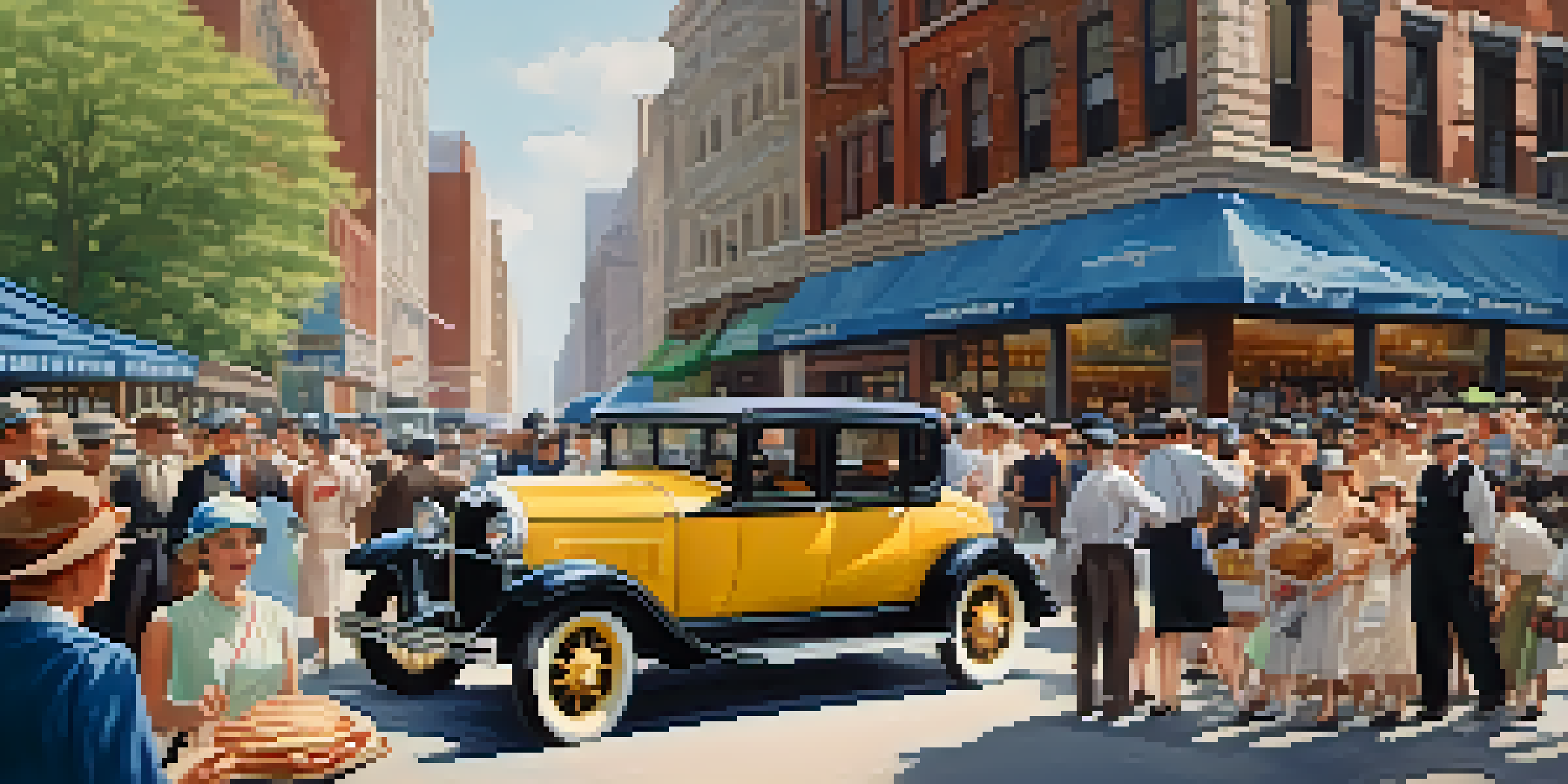The Evolution of NYC Sports Culture Over the Decades

The Roaring Twenties: Sports as Entertainment
The 1920s marked a vibrant time for sports in New York City, with baseball and boxing taking center stage. The New York Yankees, led by the legendary Babe Ruth, captivated fans with their thrilling games, while boxing champions like Jack Dempsey drew massive crowds. This era showcased sports not just as competition, but as a major form of entertainment, blending the excitement of the game with the glitz of celebrity culture.
Sports do not build character. They reveal it.
As radio broadcasts began to emerge, fans could follow their favorite teams from the comfort of their homes, further cementing the connection between sports and entertainment. This accessibility opened up new avenues for fandom, allowing the working class to engage with their heroes in a way that was previously unimaginable. Sports stars became cultural icons, representing aspirations and dreams for many New Yorkers.
The roaring twenties set the stage for a sports culture that would continue to evolve, paving the way for future generations to embrace not only the games but the lifestyles associated with them. The excitement of this decade laid the groundwork for the passionate sports landscape NYC is known for today.
The Gritty Thirties: Resilience in Sports
The Great Depression hit hard in the 1930s, but sports provided a much-needed escape for New Yorkers facing economic hardship. Teams like the New York Giants in football and the Brooklyn Dodgers in baseball emerged as symbols of resilience, embodying the fighting spirit of the city. Fans rallied behind their teams, creating a sense of community and hope amidst the struggles.

During this decade, sports events also began to serve as social gatherings where diverse groups came together, showcasing NYC’s melting pot of cultures. The integration of sports was slow, but significant figures like Jackie Robinson began to break down racial barriers, paving the way for more inclusive sports culture. This shift not only transformed the teams but also the very fabric of society at that time.
Sports as Cultural Icons
In the 1920s, sports in NYC evolved into a major form of entertainment, with athletes like Babe Ruth becoming cultural icons.
The thirties highlighted the power of sports as a tool for unity, reinforcing that even in the toughest times, New Yorkers could find common ground through their love for the game. The resilience shown during this period would echo through the decades, shaping the city’s identity in the sports realm.
The Forties and Fifties: The Golden Age of Sports
The 1940s and 1950s are often referred to as the golden age of sports in New York City, with the emergence of iconic figures and legendary teams. The New York Yankees continued to dominate baseball, while the Brooklyn Dodgers made their mark with innovative play. This period also saw the rise of basketball, with the New York Knicks capturing the hearts of fans.
The only way to prove that you’re a good sport is to lose.
The cultural significance of sports soared as games became significant social events, drawing fans from all walks of life. Public gatherings to watch games often turned into community celebrations, with neighborhoods rallying around their teams. This sense of belonging and pride was palpable, making sports an integral part of New York City's identity.
Moreover, television began to change the landscape of sports in the 1950s, bringing games into households across the city. This evolution further fueled fandom, allowing fans to connect with their favorite athletes and teams like never before, solidifying sports as a cornerstone of NYC culture.
The Sixties: Social Change and Sports
The 1960s were a time of social upheaval, and sports were not immune to these changes. Athletes like Muhammad Ali and Jim Brown began using their platforms to advocate for civil rights, intertwining sports with social justice movements. This shift challenged the notion of sports as merely entertainment and encouraged fans to engage with broader societal issues.
The New York Mets' stunning victory in the 1969 World Series served as a unifying moment for the city, demonstrating how sports could transcend everyday struggles. This underdog story resonated with many New Yorkers, showcasing how perseverance and teamwork could lead to success—a narrative that paralleled the social movements of the era.
Resilience Through Tough Times
During the Great Depression of the 1930s, sports provided a sense of community and hope for New Yorkers facing economic hardship.
Sports became a powerful voice for change, inspiring fans to consider the implications of their support. The sixties highlighted the evolution of sports culture into a platform for expression, setting the stage for future athletes to make bold statements both on and off the field.
The Seventies: Diversity and Expansion
The 1970s saw a significant diversification of sports culture in NYC, with the rise of new teams and the increasing visibility of female athletes. The New York Knicks' success in the NBA and the emergence of the New York Cosmos in soccer represented a blossoming of sports options for fans. This decade was marked by an explosion of interest in various sports, accommodating a wider range of preferences.
Women's sports began to gain traction during this time, with the establishment of the Women's Sports Foundation in 1974 and the rise of female figures in sports like tennis champion Billie Jean King. These changes set a precedent for future generations, encouraging girls to pursue athletics without limitations. The focus on inclusivity was palpable, as diverse communities found representation in sports.
Moreover, the decade's cultural shifts encouraged fans to embrace not just the games but also the stories behind the athletes. This deeper connection to sports further enriched the city’s sports culture, inviting more voices to the forefront and creating a vibrant tapestry of athletic prowess in NYC.
The Eighties: Commercialization and Media Influence
The 1980s brought a wave of commercialization and media influence that transformed the sports culture in NYC. With the rise of cable television and advertising, teams became brands, and athletes were marketed as celebrities. This shift changed the way fans interacted with sports, as games became events that were heavily covered and scrutinized.
The New York Yankees and the New York Knicks capitalized on this trend, leveraging their storied histories and star players to attract larger audiences. The excitement surrounding these teams reached new heights, creating a culture of fandom that emphasized loyalty and investment. The concept of being a 'superfan' emerged, where fans not only supported their teams but also engaged in a lifestyle centered around them.
Inclusivity and Globalization
The 2000s marked a new era in NYC sports culture, emphasizing inclusivity and globalization, allowing diverse communities to connect through athletics.
As sports became more commercialized, the fan experience evolved with it. Merchandise sales soared, and arenas transformed into entertainment hubs. This era marked a pivotal moment where sports culture intertwined with consumerism, changing the landscape of how New Yorkers engaged with their favorite teams.
The New Millennium: Inclusivity and Globalization
Entering the 2000s, NYC sports culture embraced inclusivity and globalization like never before. With the advent of social media, fans could connect with teams and athletes on a personal level, fostering a sense of community that transcended geographical boundaries. NYC’s diverse population found representation in various sports, showcasing the city’s melting pot of cultures.
The success of teams like the New York City FC in soccer and the increased visibility of women’s sports reflected a broader acceptance of different forms of athletic expression. This era highlighted how sports could unite people across cultural divides, creating a shared passion that resonated deeply within the city. The emphasis on inclusivity encouraged future generations to participate in sports, regardless of background.

Moreover, the globalization of sports brought international events to NYC, attracting fans from around the world. Events like the NYC Marathon showcased the city's rich tapestry of cultures, reinforcing the idea that sports can serve as a universal language. This new chapter in NYC sports culture emphasized connection, representation, and the celebration of diversity.